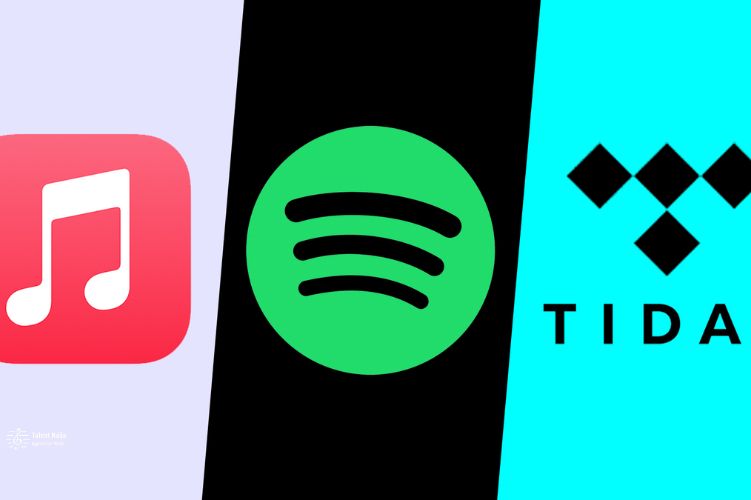As a professional musician and music producer with over 7 years of experience in the industry, I’ve tried all the major music streaming platforms extensively. We all have unique listening habits and budgets, so there is no one-size-fits-all streaming service. In this article, I’ll compare the top 5 contenders—Spotify, Apple Music, Amazon Music Unlimited, YouTube Music, and Tidal—across key factors to help you decide which is best suited for your needs. Read below about “Top 5 Music Streaming Services Compared: Which One is Right for You?”.
Table of Contents
Top 5 Music Streaming Services Compared: Which One is Right for You?
1. Spotify
With over 82 million tracks and 406 million monthly active users, Spotify is the most popular streaming service globally. I’ve been using Spotify personally for over 5 years and have also distributed my own music on the platform.
- Library Size & Selection: Spotify offers the largest music catalog among streaming platforms. You’ll find music across genres from major label artists as well as independents. Its algorithmic recommendations are also best-in-class, helping you discover new artists tailored to your taste.
- Sound Quality: Spotify streams music at up to 320kbps bitrate on its premium plan. While Apple Music and Tidal offer lossless quality, I find Spotify’s sound to be crisp and clear for most listener needs. Plus, Spotify Connect allows you to stream wirelessly to speakers.
- Pricing: Spotify has a free ad-supported tier along with paid plans starting from $9.99/month. As a musician, I appreciate that Spotify has the most subscriber-friendly artist payout rates in the industry.
- Key Takeaway: With its vast catalog and personalization, Spotify is my top choice for most music listeners. The sound quality is good for casual listening and Spotify pays artists the best per stream.
2. Apple Music
As an iPhone user, I use Apple Music (75 million tracks) for streaming as it integrates cleanly with my device. However, Android and other device users may find the experience to be subpar.
- Library Size & Selection: Apple Music has a large catalog, but still smaller than Spotify’s. I’ve found some independent artist releases missing from Apple Music. But it does have a growing music video collection (over 100K).
- Sound Quality: Apple Music streams at 256kbps AAC bitrate by default but offers lossless audio at no extra cost. So audiophiles will enjoy
- for its sound fidelity.
- Pricing: Like Spotify, Apple Music starts from $9.99/month. One advantage I’ve experienced as a musician is that Apple Music pays slightly better streaming royalties to artists than Spotify.
- Key Takeaway: Apple Music is great for those in the Apple ecosystem looking for deep iOS integration, music videos and lossless sound quality.

3. Amazon Music Unlimited
Having used Amazon Music Unlimited for over 2 years, I think it makes for a decent Spotify alternative – especially for Amazon Prime members.
- Library Size & Selection: Amazon Music Unlimited has over 90 million songs which is impressive but still trails Spotify and Apple Music somewhat in terms of latest releases and catalog depth. On the plus side, it has a growing catalog of spatial audio tracks.
- Sound Quality: Standard streams max out at 256kbps bitrate. There is an upgraded Individual Plan at $14.99/month or Family Plan at $19.99/month that offers HD and Ultra HD streaming up to 24-bit/192kHz which is great.
- Pricing: It starts from $8.99/month for Prime members. So if you already have a Prime subscription, this is a cost-effective add-on.
- Key Takeaway: Amazon Music Unlimited is good value with competitive pricing for Prime members. It also offers upgraded lossless tiers for audiophiles.
4. YouTube Music
As a video creator, I use YouTube Music (over 80 million official songs) to track stats on my music uploads. Beyond that, I find the library to be lacking in parts.
- Library Size & Selection: YouTube Music combines official releases with remixes, live performances, and other user-generated content. But its catalog of studio recordings falls short of leading services. I’ve had trouble finding some albums.
- Sound Quality: Audio quality maxes out at 256kbps AAC bitrate even on its premium tier. For video streaming, YouTube offers 1080p HD on premium. Spatial audio is missing at the moment.
- Pricing: The premium ad-free tier costs a very affordable $9.99/month. It also includes YouTube video streaming without ads. There is a free ad-supported radio tier as well.
- Key Takeaway: YouTube Music is best suited for fans of remixes, covers, and live concert footage. But its catalog of studio albums trails rivals.
5. Tidal
As a hi-fi enthusiast, I subscribe to Tidal (over 80 million tracks) for its superior lossless sound quality. But its smaller user base has some drawbacks.
- Library Size & Selection: Tidal has a comprehensive catalog that is on par with Apple Music but falls short of Spotify’s depth. Its curated editorial is excellent. But algorithmic personalization is not as polished.
- Sound Quality: Tidal streams lossless CD-quality audio on its $9.99/month Premium tier. And the $19.99/month HiFi plan offers 24-bit Hi-Res streams up to 9216 kbps bitrate for the ultimate fidelity.
- Pricing: Tidal is positioned as a more premium service with lossless tiers starting from $9.99/month going up to $19.99/month. These prices are justifiable given Tidal pays artists the highest per stream.
- Key Takeaway: Audiophiles will love Tidal HiFi’s lossless sound. But its smaller user base impacts personalization.
- Also watch: https://www.youtube.com/watch?v=TZKW2w5V4Ck
The Bottom Line
Ultimately there is no outright “best” music streaming service today. Each has its unique strengths and suits differing listener priorities. Casual listeners are well served by Spotify with its unmatched catalog breadth, discovery, and sharing features. Audiophiles will gravitate towards Tidal or, for some, Amazon Music Unlimited’s Hi-Res plan. iOS users, especially with a HomePod, can enjoy Apple Music’s lossless audio and iCloud continuity. YouTube Music caters to fans seeking live performances and remixes.
I hope this detailed comparison helps you decide which streaming service will satisfy your listening habits. As an artist myself, I’m glad we have access to so many ways of reaching fans with our music today at scale. Feel free to reach out with any other questions! I hope you like reading “Top 5 Music Streaming Services Compared: Which One is Right for You?”.

With a Master’s degree in Musicology and over 4+ years of experience in promoting musical talent, our author brings a blend of academic expertise and real-world insights to TalentNaija. Passionate about showcasing diverse musical genres, emerging artists, and industry trends, they provide practical tips and authentic experiences for music enthusiasts. Connect on Instagram @talentnaija_official and Facebook Talent Naija for the latest updates and inspiration.
Connect with Us:
Instagram: @talentnaija_official
Facebook: Talent Naija


